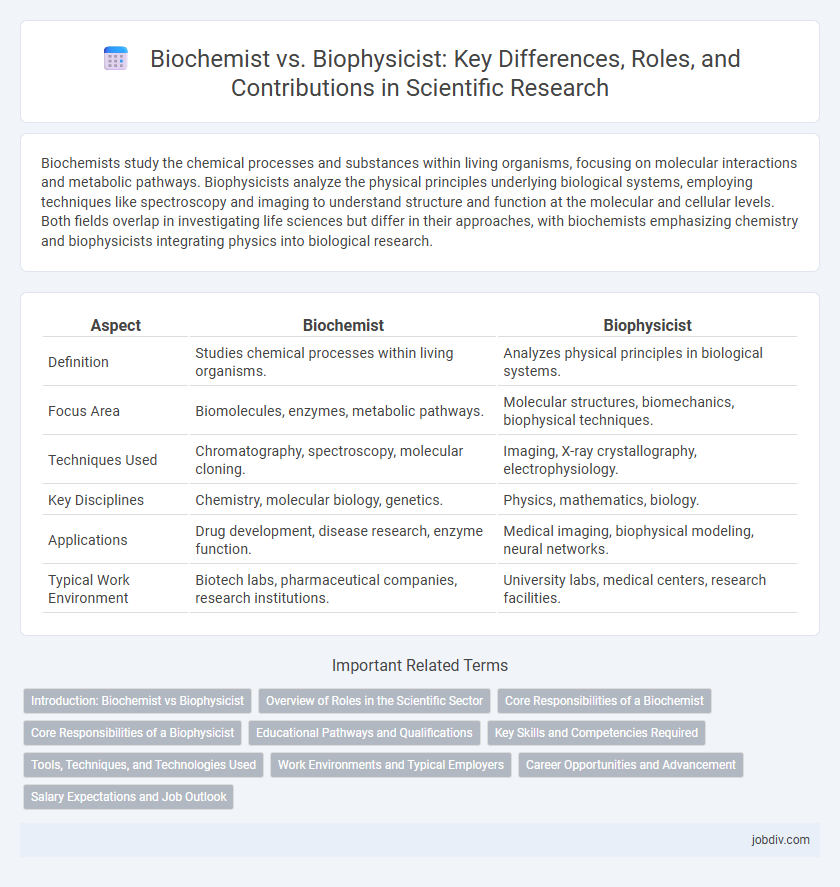Biochemists study the chemical processes and substances within living organisms, focusing on molecular interactions and metabolic pathways. Biophysicists analyze the physical principles underlying biological systems, employing techniques like spectroscopy and imaging to understand structure and function at the molecular and cellular levels. Both fields overlap in investigating life sciences but differ in their approaches, with biochemists emphasizing chemistry and biophysicists integrating physics into biological research.
Table of Comparison
| Aspect | Biochemist | Biophysicist |
|---|---|---|
| Definition | Studies chemical processes within living organisms. | Analyzes physical principles in biological systems. |
| Focus Area | Biomolecules, enzymes, metabolic pathways. | Molecular structures, biomechanics, biophysical techniques. |
| Techniques Used | Chromatography, spectroscopy, molecular cloning. | Imaging, X-ray crystallography, electrophysiology. |
| Key Disciplines | Chemistry, molecular biology, genetics. | Physics, mathematics, biology. |
| Applications | Drug development, disease research, enzyme function. | Medical imaging, biophysical modeling, neural networks. |
| Typical Work Environment | Biotech labs, pharmaceutical companies, research institutions. | University labs, medical centers, research facilities. |
Introduction: Biochemist vs Biophysicist
Biochemists study the chemical processes within and related to living organisms, focusing on molecular interactions, enzymes, and metabolic pathways to understand cellular function. Biophysicists apply principles of physics to analyze the structural and mechanistic properties of biological molecules, employing techniques like spectroscopy and crystallography. Both disciplines overlap in investigating life at a molecular level but differ in their approaches, with biochemists emphasizing chemical composition and reactions, and biophysicists prioritizing physical principles and quantitative models.
Overview of Roles in the Scientific Sector
Biochemists analyze the chemical processes and substances that occur within living organisms, focusing on molecular interactions and enzymatic activities essential for understanding metabolism and genetic expression. Biophysicists apply principles of physics to study the structure, dynamics, and mechanics of biological systems, utilizing techniques such as spectroscopy, microscopy, and computational modeling to elucidate biological phenomena. Both professions collaborate extensively in research institutions and pharmaceutical development to advance knowledge in molecular biology and medical innovations.
Core Responsibilities of a Biochemist
Biochemists primarily investigate the chemical processes and substances within living organisms, focusing on molecular interactions and metabolic pathways. They analyze enzymes, proteins, and nucleic acids to understand cellular functions and biochemical mechanisms underlying health and disease. Their core responsibilities include designing experiments, conducting laboratory analyses, and interpreting data to develop pharmaceuticals, diagnostics, and biotechnological applications.
Core Responsibilities of a Biophysicist
Biophysicists apply principles of physics and mathematics to understand the structural and functional properties of biological molecules and systems, employing techniques such as spectroscopy, microscopy, and computational modeling. Their core responsibilities include analyzing molecular interactions, studying cellular processes at the atomic level, and developing quantitative models to explain biological phenomena. Unlike biochemists who focus on chemical reactions and metabolism, biophysicists emphasize physical mechanisms underlying biomolecular structure and dynamics.
Educational Pathways and Qualifications
Biochemists typically pursue a bachelor's degree in biochemistry or chemistry, often advancing to master's or PhD programs specializing in molecular biology, enzymology, or metabolic pathways. Biophysicists generally start with undergraduate studies in physics, biology, or biophysics, followed by graduate education focused on applying physics principles to biological systems, including structural biology and computational modeling. Both fields require strong foundations in chemistry, biology, and mathematics, with increasing emphasis on interdisciplinary skills at the doctoral level to address complex biological questions.
Key Skills and Competencies Required
Biochemists require expertise in molecular biology techniques, enzymatic assays, and chemical analysis to investigate biochemical processes at the cellular level. Biophysicists must demonstrate proficiency in quantitative methods, computational modeling, and physical principles to analyze biological systems from a physics perspective. Both fields demand strong analytical skills, laboratory proficiency, and interdisciplinary knowledge bridging biology, chemistry, and physics.
Tools, Techniques, and Technologies Used
Biochemists primarily utilize chromatography, mass spectrometry, and X-ray crystallography to analyze molecular structures and biochemical processes, employing techniques such as enzyme assays and protein purification. Biophysicists rely on NMR spectroscopy, cryo-electron microscopy, and atomic force microscopy to investigate the physical properties of biological molecules, leveraging computational modeling and single-molecule fluorescence methods. Both disciplines integrate advanced imaging technologies and bioinformatics tools to explore biomolecular dynamics and interactions at cellular and molecular levels.
Work Environments and Typical Employers
Biochemists primarily work in pharmaceutical companies, academic research institutions, and government laboratories, where they focus on studying the chemical processes within living organisms. Biophysicists often find employment in medical research facilities, biotechnology firms, and universities, leveraging physics principles to understand biological systems. Both professions frequently collaborate with healthcare organizations and private industry to develop innovations in drug design, molecular imaging, and genetic engineering.
Career Opportunities and Advancement
Biochemists often find career opportunities in pharmaceuticals, biotechnology, and clinical research, focusing on molecular processes within living organisms, which leads to advancements in drug development and metabolic studies. Biophysicists apply principles of physics to biological systems, offering career paths in medical imaging, structural biology, and biophysical instrumentation, contributing to innovations in diagnostic technology and protein analysis. Both fields provide advancement through interdisciplinary research, with increasing demand for expertise in computational modeling and experimental techniques driving professional growth.
Salary Expectations and Job Outlook
Biochemists typically earn a median annual salary of around $94,000, with job growth projected at 8% over the next decade, reflecting steady demand in pharmaceuticals and biotechnology. Biophysicists, often earning slightly higher median salaries near $106,000, face a similar job outlook growth rate of about 7%, driven by advancements in medical research and nanotechnology. Both careers require advanced degrees and offer strong prospects in academic, industrial, and government research sectors.
Biochemist vs Biophysicist Infographic

 jobdiv.com
jobdiv.com